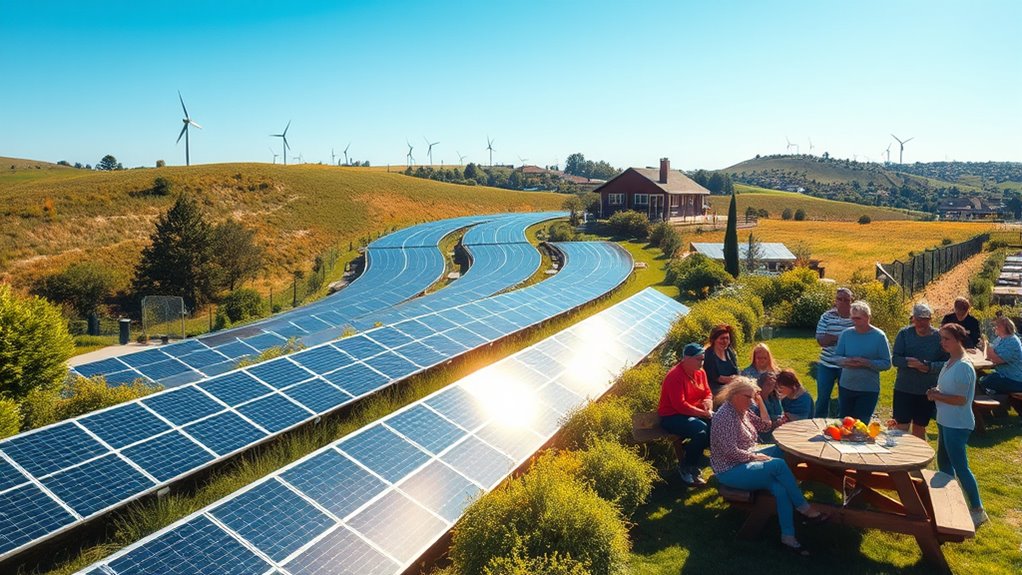Community solar projects let you share in the benefits of renewable energy without needing to install panels on your own roof. You can participate by subscribing to shared solar installations in accessible locations, such as open spaces or commercial rooftops. These projects often come with financial incentives like tax credits and rebates, helping to lower costs and energy bills. They connect to the grid, reducing reliance on traditional utilities while supporting sustainability. Explore further to discover how these projects can make clean energy more accessible for you.
Key Takeaways
- Community solar enables collective access to renewable energy without individual rooftop installations.
- Participants receive energy credits, reducing their electricity bills and increasing affordability.
- Projects connect to local grids, supporting energy stability and allowing excess power to be fed back.
- Incentives like tax credits and rebates lower installation costs, encouraging wider participation.
- Community solar promotes environmental sustainability and local economic growth through job creation.

Have you ever wondered how communities can harness solar power together? Community solar projects make it possible for individuals and organizations to benefit from renewable energy without installing panels on their own rooftops. Instead, a shared solar installation is set up in a convenient location, like a large open space or commercial rooftop, and everyone who participates receives a portion of the energy generated. This approach makes solar power accessible to those who may not have suitable roofs or the upfront capital to invest in individual systems. It’s a smart way to expand access to clean energy while fostering a sense of community involvement.
One of the key factors that encourage participation in community solar projects is the availability of solar panel incentives. Governments and utilities often offer financial incentives such as tax credits, rebates, or grants to lower the cost of installation and make these projects more attractive. These incentives help reduce the upfront investment required, making it easier for community members to join in. By taking advantage of these incentives, you can see quicker returns on your investment and enjoy lower electricity bills without the hassle of maintaining a personal solar system. Additionally, many states have policies that support community solar, further boosting its appeal and making it a practical choice for many households and businesses. Leveraging energy efficiency standards can also enhance the overall sustainability of such projects.
Another vital aspect of community solar projects is grid integration. When you participate in such a project, your shared solar energy is connected to the local power grid. This connection allows excess power generated by the community solar farm to be fed back into the grid, providing benefits to the broader community and stabilizing the overall energy supply. Grid integration also ensures that you receive credits or compensation for the electricity your portion of the community solar system produces. This process, often facilitated through net metering policies, helps you offset your energy consumption and reduces your reliance on the traditional utility grid. It also encourages renewable energy adoption, which can be further supported by effective policy frameworks that promote clean energy initiatives. Additionally, integrating renewable energy sources like solar power supports efforts to reduce greenhouse gas emissions and combat climate change. A well-designed community solar project can also promote local economic development, creating jobs and supporting local businesses during installation and maintenance.
Frequently Asked Questions
How Are Community Solar Projects Funded and Financed?
You can fund community solar projects through various means, often leveraging solar incentives and project partnerships. These incentives help reduce upfront costs, making projects more affordable. Partnerships with local utilities, developers, and investors share the financial burden and benefits. By combining these sources, you guarantee the project’s success and expand access to renewable energy, allowing more people to benefit from solar power without installing panels on their own property.
What Are the Eligibility Criteria for Participating in Community Solar?
Imagine enjoying solar benefits without installing panels—your solar eligibility hinges on it. To participate, you usually need a suitable property, meet specific credit requirements, and be within the project’s service area. While some programs are open to renters, others favor homeowners. Your participation criteria ensure fair access, making it easier for diverse households to share renewable energy, all while supporting clean power initiatives.
How Do Community Solar Projects Impact Local Energy Rates?
Community solar projects can lower your energy rates by providing energy cost savings through shared renewable energy. When you participate, you often pay less for electricity because the community harnesses solar power more efficiently. Plus, these projects encourage community engagement, making everyone part of the solution. As a result, your energy bills tend to decrease, and you help promote sustainable energy use in your neighborhood.
Can Renters Participate in Community Solar Programs?
Renters, you’ll love this—participating in community solar is easier than ever! You don’t need your own rooftop; just sign up for a solar farm’s leasing options, and you can enjoy clean energy benefits without installing panels. This means you can support renewable energy and cut your bills, even if you’re in an apartment. It’s a simple way to join the solar revolution and make a positive impact.
What Are the Long-Term Maintenance Responsibilities for Participants?
You’ll have some long-term maintenance responsibilities as a participant, mainly involving equipment upkeep. It’s important to stay informed about your obligations, like monitoring system performance and reporting issues promptly. While the hosting organization handles most of the installation and major repairs, you might need to assist with basic upkeep tasks to ensure the system runs smoothly. Being proactive helps maximize your solar benefits and keeps the project sustainable over time.
Conclusion
By getting involved in community solar projects, you’re not just sharing renewable energy benefits—you’re helping to build a brighter, greener future for everyone. These initiatives make solar power accessible and affordable, proving that many hands make light work. So, don’t wait for the perfect moment; now’s your chance to jump in and make a real difference. Remember, the early bird catches the worm—your small step today can lead to big changes tomorrow.










